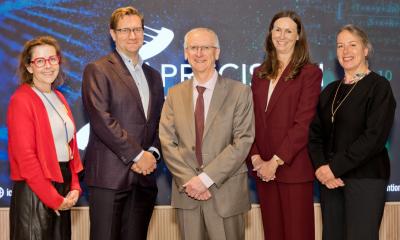Interfere or Interact?
ECR 2013: to survive, radiologists may need to come out of the closet

“I am a radiologist – this means I am a clinician”: this perception of his own role from the chair of this ECR session, Dr Claus D. Claussen, Tübingen/Germany, does not reflect the view currently held in many hospitals. More often than not, radiologists are considered to be physicians neither by their clinical peers nor – as studies demonstrate – by patients. They are still removed from much of the action in a hospital, “coming from the dark cave”. In an era when the radiologists’ turf is increasingly being invaded by other disciplines, radiologists need to raise their profile. The only way to achieve a turnaround in prestige is by communicating and interacting – this is a key take-away message from the session entitled “The radiologist, the clinician and the patient: an impossible trio?”. The key influencing factor, according to Dr Georg Marckmann, Munich/Germany (medical ethicist), is that in the typical radiology department, time is money.
Interacting with peers: better to provide opinions, not fulfil orders
There have been counteracting trends in recent years: whereas the number of multi-disciplinary tumour boards in, e.g., Germany and Austria has gone up, involving also the radiologists, at the same time the availability of images through PACS solutions has served to decrease interaction with clinical peers.
With regard to over-imaging, a mechanism should be installed to allow for control over referrals, said Dr Jim A. Reekers, Amsterdam / the Netherlands (radiologist); emerging EU-wide guidelines should help. Modern IT has introduced a culture which all but fosters interaction between radiologist and the clinical peers: Computerized Physician Order Entry (CPOE) has served to institutionalize a process where the clinician will define an imaging method to be used for his/her patient. However, it is the radiologists who receive extensive training in imaging methodology and technology; the expertise regarding the selection of the appropriate method lies with them. A simple re-phrasing on the part of the software manufacturers could help – turning the order into a “request for consultation regarding diagnostic imaging”.
Radiologists and patients: interference or interaction?
“One face to the patient”: the non-radiologist voice at the panel was in support of the view that communication with the patient should be the task of the physician managing each case. After all, it is that physician who is in the know about that patient’s history, and it is he/she who will be aware of all diagnostic procedures in process of being carried out to attain a clear picture of the case: even if it “doesn’t hurt” if the radiologist speaks to the patient, summed up Dr Markus Peck-Radosavljevic, Vienna/Austria (internal medicine), the radiologist would not be capable of making an overall judgement to the patient with regard to findings merely based on the read. Plus – radiologists are not trained to interact with patients.
For radiologists, the willingness to interact with the patient may be impacted by the fact that revenue depends on their number of reads. In the US however, generally perceived as a classic “time is money” environment, selected payers will cut reimbursement for cases where mandatory interaction with patients doesn’t take place.
Radiologists should consider their relationship with the patient as their primary concern – and not that with clinical peers, said Dr Andy Adam, London/UK (radiologist). Direct interaction with patients may well be seen as a sine-qua-non for quality of care. This would help avoid cases which can even turn into liability issues – when patients are made to wait for weeks until they are finally informed by their first-line physician about the status of their oncological condition.
In today’s atmosphere dominated by commercialization of medical services, remote diagnostics done through teleradiology add challenges to any interaction with peers and patients – stakeholders in the care chain may not feel motivated to utilize any cellular phone number of a radiologist acting somewhere in the distance. Another message to take away from this session was that the (re-)conversion of the radiology, radio-oncology, and possibly clinical oncology into a combined field might be an appropriate option in the light of repositioning of disciplines. The issue is not that of a mere trio composed of a radiologist, clinician, and patient, summed up Dr Marckmann; instead the scenario is “a complex orchestra” involving radiologists’ understanding of their own role, visibility needs, intra-hospital marketing, as well as time and money.
by Michael Reiter
11.03.2013





